If you’re building a YouTube channel to grow your brand or monetize your content, there’s one rulebook you can’t afford to ignore: the YouTube Community Guidelines.
These guidelines are like the platform’s constitution, setting the tone for what’s allowed, what’s restricted, and what could get your channel in serious trouble.
Whether you’re a new creator or a seasoned YouTuber, understanding these rules helps protect your account, maintain your reputation, and ensure long-term success.
This cheat sheet breaks down what you need to know about YouTube’s Community Guidelines, what happens when you get a strike, and how to stay on the right side of the rules.
Table of Contents
Why Are YouTube Community Guidelines Important?

YouTube’s Community Guidelines exist to make the platform a safe, fair, and respectful place for both creators and viewers.
Since billions of people use YouTube daily, the guidelines ensure that content remains appropriate for all audiences while protecting advertisers and the integrity of the platform.
For creators, following these rules isn’t just about avoiding punishment. It’s about building credibility.
A channel that plays by the rules earns YouTube’s trust, which often leads to better algorithmic reach, monetization approval, and partnership opportunities.
Violating the guidelines can result in content removal, demonetization, or even account termination. But when you understand how they work, you can confidently create without worrying about losing your hard-earned audience.
YouTube Community Guidelines: What Creators Need to Know
Every creator on YouTube agrees to follow the Community Guidelines when uploading videos.
These rules cover everything from hate speech and harassment to misleading content and spam.
While they may sound complex, they mostly boil down to two main principles: honesty and respect.
Be Honest
YouTube values transparency. That means no fake engagement, no misleading thumbnails, and no deceptive titles designed to trick viewers.
Content like clickbait scams, impersonation, or manipulated media can trigger guideline violations.
To stay honest:
- Always represent your content accurately in the title, description, and thumbnail.
- Avoid spreading misinformation or manipulated content.
- Disclose sponsorships and paid promotions clearly.
- Never impersonate another creator or brand.
Honesty builds audience trust and helps your channel grow sustainably. It’s not just about following the rules; it’s about establishing yourself as a reliable voice in your YouTube niche.
Be Cool
Being “cool” on YouTube simply means treating your audience (and other creators) with respect. Avoid hate speech, bullying, harassment, or promoting dangerous behavior.
YouTube takes violations in this area seriously because they can harm real people.
Here’s what to avoid:
- Hate or harassment toward individuals or groups.
- Encouraging harm, violence, or illegal activity.
- Graphic or sexually explicit content that violates age restrictions.
- Dangerous “challenges” or stunts that could cause injury.
If you keep your content positive, helpful, or entertaining, you’ll rarely have issues. YouTube’s goal isn’t to restrict creativity. It’s to keep the platform enjoyable and safe for everyone.
Three YouTube Community Guidelines Strikes and You’re Out
YouTube uses a three-strike system to manage guideline violations. It’s simple: each time you break a rule, you receive a “strike.” After three strikes within a 90-day period, your channel can be permanently removed.
Before getting a strike, you may receive a warning, basically giving you a chance to learn what went wrong and correct it.
YouTube understands that mistakes happen, so the first issue usually comes with education instead of punishment.
Once you start receiving strikes, however, consequences escalate quickly.
This also applies to YouTube shorts.

First Community Strike
If you get your first strike, YouTube will temporarily restrict your account. You won’t be able to upload new videos, go live, or post to the Community tab for one week.
YouTube also removes the video that caused the strike and sends an email explaining the violation. During this time, it’s crucial to review the Community Guidelines carefully so you can avoid making the same mistake again.
The first strike expires after 90 days, but it stays on record until then. Use that time to rebuild trust by posting compliant, high-quality content.
Second Community Strike
A second strike within 90 days means YouTube considers your channel at risk. This time, you’ll lose the ability to upload or live stream for two weeks.
At this stage, YouTube expects you to take the situation seriously. Another violation could mean losing your entire channel, so it’s smart to pause and re-evaluate your content strategy.
If you believe the strike was issued by mistake, you can appeal the decision. YouTube allows creators to request a review, but it’s important to provide evidence and a clear explanation of why the removal was unjustified.
Third Community Strike
The third strike is the final one, and the most severe. If you receive three Community Guidelines strikes within a 90-day window, YouTube will permanently terminate your channel.
All your videos, playlists, and subscribers will be removed, and you won’t be able to create another channel under the same Google account.
It’s possible to appeal, but very few terminations are reversed. By this point, YouTube has determined that your content repeatedly violates the guidelines.
Staying compliant and understanding where the lines are drawn is the best way to avoid ever reaching this point.
YouTube Community Guidelines: Understanding Strikes
Each strike represents a specific type of violation, and not all strikes are the same. YouTube classifies strikes into categories such as:
- Nudity and sexual content
- Harmful or dangerous acts
- Hate speech or harassment
- Spam, scams, and deceptive practices
- Violent or graphic content
- Child safety violations
These categories help YouTube maintain clarity and fairness. When you receive a strike, you’ll see exactly what type of rule was broken and how it applies.
It can be based on your YouTube video content, or even hashtags and other parts of your video like the thumbnail.
If you have a lot of bad YouTube comments, you may also find you get flagged.
Creators often confuse Community Guidelines strikes with copyright strikes, but they are different.
Copyright strikes come from violating someone else’s intellectual property, while Community Guidelines strikes are about behavior, safety, and platform policy.
To avoid confusion, think of copyright strikes as “legal” issues and community strikes as “ethical” issues, both can hurt your channel, but for different reasons.
As soon as you find you’ve violated YouTube community guidelines, you should take steps to fix it.

Stay on the Right Side of the Rules
YouTube isn’t out to get creators: it’s trying to protect users, advertisers, and the platform’s integrity. Staying compliant is easy when you approach content creation with transparency, respect, and awareness.
Here are a few practical tips to help you stay safe and monetized:
- Review the rules regularly. YouTube updates its policies over time, especially around trending content or sensitive topics.
- Use YouTube Studio analytics. Watch how your audience interacts and flag potential concerns early.
- Avoid controversial topics unless you’re confident you can handle them responsibly.
- Mark videos correctly. Use the “made for kids” setting, age restrictions, and disclaimers where appropriate.
- Think before uploading. If you’re unsure whether a video crosses the line, it’s better to revise it first.
- Make sure your thumbnail and YouTube end screen are not in violation of any guidelines.
Remember, the most successful YouTubers aren’t just creative; they’re also careful. Following the guidelines keeps your channel healthy, your income steady, and your reputation strong.
FAQs
What are the community guidelines of YouTube?
YouTube’s Community Guidelines are the official rules that govern behavior and content on the platform. They prohibit hate speech, harassment, misleading information, spam, dangerous acts, and explicit material. Violating them can lead to strikes, suspension, or termination.
What content is restricted on YouTube?
Restricted content includes anything that promotes harm, illegal activities, discrimination, or sexual content not suitable for general audiences. YouTube also restricts violent or graphic imagery, scams, and videos spreading false or deceptive information.
Why is YouTube suppressing my comments?
YouTube may limit or hide comments if they violate policies against spam, harassment, or hate speech. Sometimes, the system automatically filters comments for review to prevent offensive or inappropriate content from appearing publicly.
What is not allowed on YouTube Shorts?
Shorts follow the same guidelines as regular videos. You can’t post violent, misleading, or explicit content. Additionally, repetitive uploads or Shorts designed to game the YouTube algorithm (like reusing the same clip multiple times) can be flagged as spam.
Final Takeaways: YouTube Community Guidelines
Understanding and following YouTube’s Community Guidelines is essential for every creator aiming to grow and monetize YouTube successfully.
Ultimately, the rules aren’t there to limit creativity; they exist to protect your content, your audience, and the platform itself.
By being honest, respectful, and mindful of what you upload, you can focus on creating videos that inspire and engage rather than worry about strikes or removals.
Stay transparent with your audience, avoid misleading content, and handle sensitive topics responsibly. When you play by the rules, YouTube rewards you with more visibility, better engagement, and a long-lasting path to monetization.
Think of the Community Guidelines as your roadmap to sustainable growth on YouTube. Follow them, and your channel can thrive for years to come.



